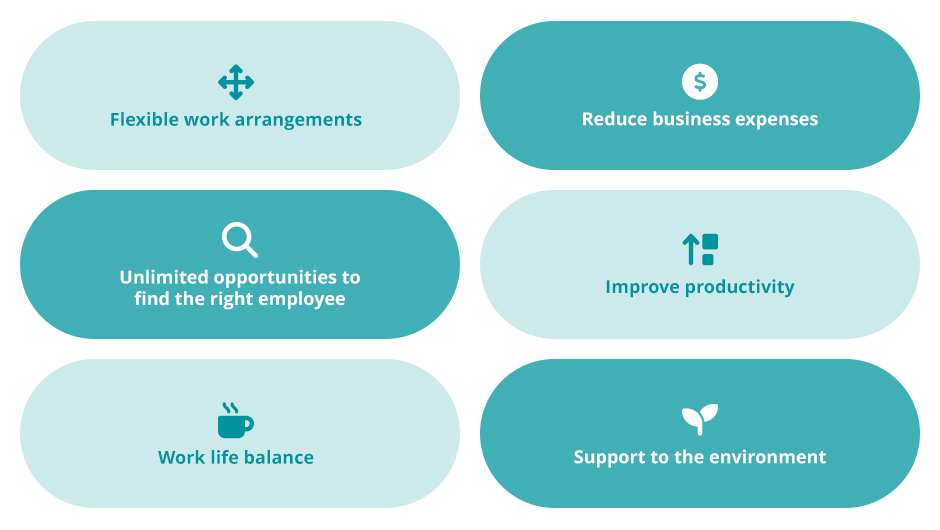TABLE OF CONTENTS
- Remote work is increasing across all industries…
- Benefits of hiring remote employees
- 1. Offering flexible work makes you attractive to employees
- 2. Reduce business expenses
- 3. Reach the exact right fit for the role
- 4. Improve productivity
- 5. Increase work-life balance
- 6. Support to the environment
- How to find remote candidates?
- What else to consider when hiring remote employees?
- Company culture
- Employee workspaces
- Language and employee location
If you’re growing your accounting firm, advisory service, or bookkeeping business, putting serious consideration into hiring remote instead of office-based workers, could prove worthwhile.
Modern cloud accounting tools, management and productivity software, and the proliferation of MS Teams or Zoom means hiring remote employees is easier than ever. The technology is there, the willingness and ability of prospective remote staff are clear, and the benefits are attractive for both parties.
Remote work is increasing across all industries…
Post-pandemic, it’s no secret that remote working is likely to stick as a new normal. Although a substantial number of businesses require staff based in a physical office full-time, today, many employers offer some form of hybrid or flexible arrangements at the very least.
Because many accounting tasks can be easily achieved with a laptop—along with the right software and virtual or phone meetings—the bookkeeping industry is particularly prime for hiring remote candidates.

Benefits of hiring remote employees
So why should you consider recruiting a remote worker for your accounting firm? Here are some of the primary benefits of doing so…
1. Offering flexible work makes you attractive to employees
With fierce competition for the best workers, it’s up to you to make your accounting firm or bookkeeping business as attractive as possible to secure the best candidates. Hiring remotely could well prove to be a no-brainer in giving you and your business an edge!
2. Reduce business expenses
Write down all the business expenses you incur through having a physical office space. What are the overheads for in-office workers?
- rent for the space
- desks and chairs
- monitors and equipment
- consumables like coffee and refreshments
- energy and water bills
- internet
- insurance
- maintenance and security.
You won’t have to deal with any of these things if you (as the owner) are able to operate outside a physical office and embrace remote employees. This of course could make way for more money in your pocket and better cash flow, while saving your time and busy work.
3. Reach the exact right fit for the role
Your ideal employee may not live in your immediate area. In fact, there’s only a slim chance that they do. They may even be in another state or country altogether. By embracing remote workers for your accounting firm, you can cast your net far and wide to find the right employee for you.
4. Improve productivity
Despite what initial naysayers claimed, pre pandemic, remote workers have been shown over and again to be productive. When you place less value on their physical presence and rather place emphasis on deliverables, remote and flexible could improve productivity, and your bottom line. This is not just because of increased emphasis on work done, but also reflects the increased work life of your employees while eliminating any time spent on commuting and running out the clock.
5. Increase work-life balance
The benefits of increased life satisfaction cannot be understated. Happy employees are not only productive employees they’re also more likely to stick around. So, with better retention and more fulfilled workers, remote or flexible working can be a serious boon.
6. Support to the environment
Reducing the amount of petrol consumed in commuting by car or even via public transport, you’ll not only make your employees happier and wealthier you’ll also be doing your bit to reduce greenhouse gases and fossil fuel usage.
How to find remote candidates?
So, if you’re convinced of the benefits of hiring remote workers for your accounting firm or bookkeeping practice, how do you go about finding them and hiring them?
First, you need to be thorough and scrupulous when you hire remotely. With less firsthand supervision, being sure of your candidate is critical.
Obviously, a solid resume, relevant work experience, and a reliable nature are paramount considerations when you hire remote employees. However, you also need to:
- detail expected work and communication hours
- lay out KPIs and regular performance goals
- ensure they have an adequate workspace
- give them the tools and equipment they need for the role
- make sure they are comfortable with the remote tools you’ll be using
- set expectations around the regularity of meetings and WIPs.
When you hire remote teams, you’ll need to monitor them closely at first to be sure they are the right fit and perform as expected.
What else to consider when hiring remote employees?
Before you take the plunge, let’s explore some of the other aspects of remote working to factor into your decision.
Company culture
One aspect that can suffer with working remotely is workplace culture. It’s harder to foster that culture when you’re not face-to-face or able to easily connect in person. While there are ways around this, if culture is something you value highly, then this may be a drawback you can’t ignore. (Less so, however, if you have a small team.)
Employee workspaces
While you may have flexible or hybrid working on offer, as a business owner you’ll still need to ensure a fit-for-purpose workspace for your employee. Your employee needs an adequate environment from which to operate. You don’t want them on a client meeting from a busy loungeroom with kids and dogs running around in the background. You also need to be sure of the security and privacy of their intended work environment as you’ll no doubt be dealing with sensitive client data and conversations.
Language and employee location
This should be obvious, but you want to make sure you have minimal language barriers if you choose to hire a remote worker. Outsourcing to an offshore candidate might be technically cheaper but can certainly have its drawbacks in terms of communication. Sometimes the location of your employee must at least fit your time zones. And in many cases you’ll want someone that can match your office hours and work schedule…

